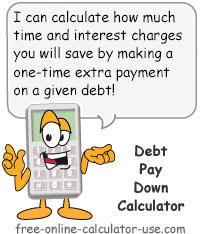IMPORTANT: Numeric entry fields must not contain dollar signs, percent signs, commas, spaces, etc. (only digits 0-9 and decimal points are allowed).
Click the Terms tab above for a more detailed description of each entry.
Step #1:
Enter the current balance owed on the debt if you were to pay off the debt today.
Step #2:
Enter the annual interest rate being charged by the lender.
Step #3:
Enter the current monthly payment amount.
Step #4:
Enter the amount you could afford to add to the next payment.
Step #5:
Tap the "Calculate Pay Down Savings" button and scroll down to view the results.


Follow me on any of the social media sites below and be among the first to get a sneak peek at the newest and coolest calculators that are being added or updated each month.